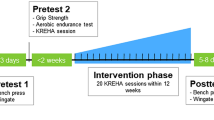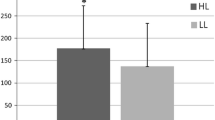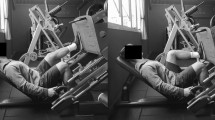Abstract
The aim of this study was to investigate the physiological responses to maximal and submaximal arm-cranking exercise in 21 individuals with tetraplegia (TP) and to evaluate the effect of a 3 and 6-month training period (mean frequency of 1.5 h · week−1, mean intensity at 35% of the training time above 60% of the heart rate reserve) on these physiological responses. The TP were divided into 8 trained subjects (T), 7 untrained subjects (U) who started their training at the beginning of the study, and 6 sedentary subjects (S). All the subjects were tested at the beginning of training and after 6 months, whereas T and U were also tested in between, at 3 months. During maximal exercise, peak power output and peak oxygen uptake per kilogram bodymass were significantly higher in T (49.9 W and 14.2 ml·min−1 · kg−1 respectively) compared to U (20.7 W and 8.8 ml · min−1 · kg−1 respectively) and S (15.9 W and 7.4 ml · min−1 · kg−1 respectively), whereas all other peak responses showed tendencies to be higher in T. This is most likely to have been the result of participation in sport and the effect of it on performance capacity in T, although differences in completeness of the lesion may have influenced the results. No significant differences were found for submaximal and maximal responses after 3 or 6 months of training in either T and U or in S. This may have been due on the one hand to the vulnerability of the subjects to diseases and injuries and on the other hand to the low frequency of training. On an individual basis, however, remark able improvement was observed during the training period, especially for individuals in the U group. These results would suggest that a 3 or 6-month training period has no measurable positive effect on the fitness level of TP.
Similar content being viewed by others
References
Burkett LN, Chisum J, Stone W, Fernhall B (1990) Exercise capacity of untrained individuals and the relationship of peak oxygen uptake to level of injury. Paraplegia 28:512–521
Coutts KD, Rhodes EC, McKenzie DC (1983) Maximal exercise responses of tetraplegics and paraplegics. J Appl Physiol 55:479–482
Coutts KD, Rhodes EC, McKenzie DC (1985) Submaximal exercise responses of tetraplegics and paraplegics. J Appl Physiol 59:237–241
Davis GM, Shephard RJ (1988) Cardiorespiratory fitness in highly active versus inactive paraplegics. Med Sci Sports Exerc 20:463–468
Dearwater SR, LaPorte RE, Robertson RJ, Brenes R, Adams LL, Becker D (1986) Activity in the spinal cord-injured patient. An epidemiologic analysis of metabolic parameters. Med Sci Sports Exerc 18:541–544
DiCarlo SE, Supp MD, Taylor HC (1983) Effect of arm ergometry training on physical work capacity of individuals with spinal cord injuries. Phys Ther 63:1104–1107
Erikson P, Lofstrom L, Ekblom B (1988) Aerobic power during maximal exercise in untrained and well-trained persons with quadriplegia and paraplegia. Scand J Rehabil Med 20:141–147
Figoni SF (1990) Perspectives on cardiovascular fitness and SCI. J Am Paraplegia Soc 13:63–71
Haas F, Axen K, Pineda H (1986) Aerobic capacity in spinal cord injured people. Cent Nerv Syst Trauma 3:77–90
Haskell WL (1994) Health consequences of physical activity: understanding and challenges regarding dose-response. Med Sci Sports Exerc 26:649–660
Hjeltnes N (1984) Control of medical rehabilitation of para and tetraplegics by repeated evaluation of endurance capacity. Int J Sports Med 5:171–174
Hjeltnes N, Vokac Z (1979) Circulatory strain in everyday life of paraplegics. Scand J Rehabil Med 11:67–73
Hoffman MD (1986) Cardiorespiratory fitness and training in quadriplegics and paraplegics. Sports Med 3:312–330
Hooker SP, Wells CL (1989) Effects of low- and moderate-intensity training in spinal cord-injured persons. Med Sci Sports Exerc 21:18–22
Hopman MTE, Oeseburg B, Binkhorst RA (1992) Cardiovascular responses in paraplegic subjects during arm exercise. Eur J Appl Physiol 65:73–78
Hopman MTE, Pistorius M, Kamerbeek ICE, Binkhorst RA (1993) Cardiac output in paraplegic subjects at high exercise intensities. Eur J Appl Physiol 66:531–535
Hopman MTE, Oeseburg B, Binkhorst RA (1994) Cardiac output determined by the CO2 rebreathing method during arm exercise. Clin Physiol 14:37–46
Janssen TWJ, van Oers CAJM, van der Woude LHV, Hollander AP (1994a) Physical strain in daily life of wheelchair users with spinal cord injuries. Med Sci Sports Exerc 26:661–670
Janssen TWJ, van Oers CAJM, van der Woude LHV, Hollander AP (1994b) Reliability of heart rate responses to non-steady-state activities of daily living in men with spinal cord injuries. Scand J Rehabil Med 26:71–78
Jehl JL, Grandmontagne M, Pastene G, Eysette M, Flandrois R, Coudert J (1991) Cardiac output during exercise in paraplegic subjects. Eur J Appl Physiol 62:256–260
Karvonen J, Vuorimaa T (1988) Heart rate and exercise intensity during sports activities. Sports Med 5:303–312
Kessler KM, Pina I, Green B, Burnett B, Laighold M, Bilsker M, Palomo AR, Myerburg RJ (1986) Cardiovascular findings in quadriplegic and paraplegic patients and in normal subjects. Am J Cardiol 58:525–530
Le CT, Price M (1982) Survival from spinal cord injury. J Chron Dis 35:487–492
Millar AL, Ward GR (1983) Physiological monitoring during intensive training of Canadian national track wheelchair athletes. Med Sci Sports Exerc 15:181–182
Sawka MN (1986) Physiology of upper-body exercise. Exerc Sport Sci Rev 14:175–211
Van Loan MD, McCluer S, Loftin JM, Boileau RA (1987) Comparison of physiological responses to maximal arm exercise among able-bodied, paraplegics and quadriplegia. Paraplegia 25:397–1105
Van Herwaarden CLA, Binkhorst RA, Fennis JFM, Van 't Laar A (1980) Reliability of the cardiac output measurement with the indirect Fick-principle for CO2 during exercise. Pflügers Arch 385:21–23
Wicks JR, Oldridge NB, Cameron BJ, Jones NL (1983) Arm cranking and wheelchair ergometry in elite spinal cord injured athletes. Med Sci Sports Exerc 15:224–231
Author information
Authors and Affiliations
Rights and permissions
About this article
Cite this article
Hopman, M.T.E., Dallmeijer, A.J., van der Woude, L.H.V. et al. The effect of training on cardiovascular responses to arm exercise in individuals with tetraplegia. Europ. J. Appl. Physiol. 74, 172–179 (1996). https://doi.org/10.1007/BF00376510
Accepted:
Issue Date:
DOI: https://doi.org/10.1007/BF00376510




